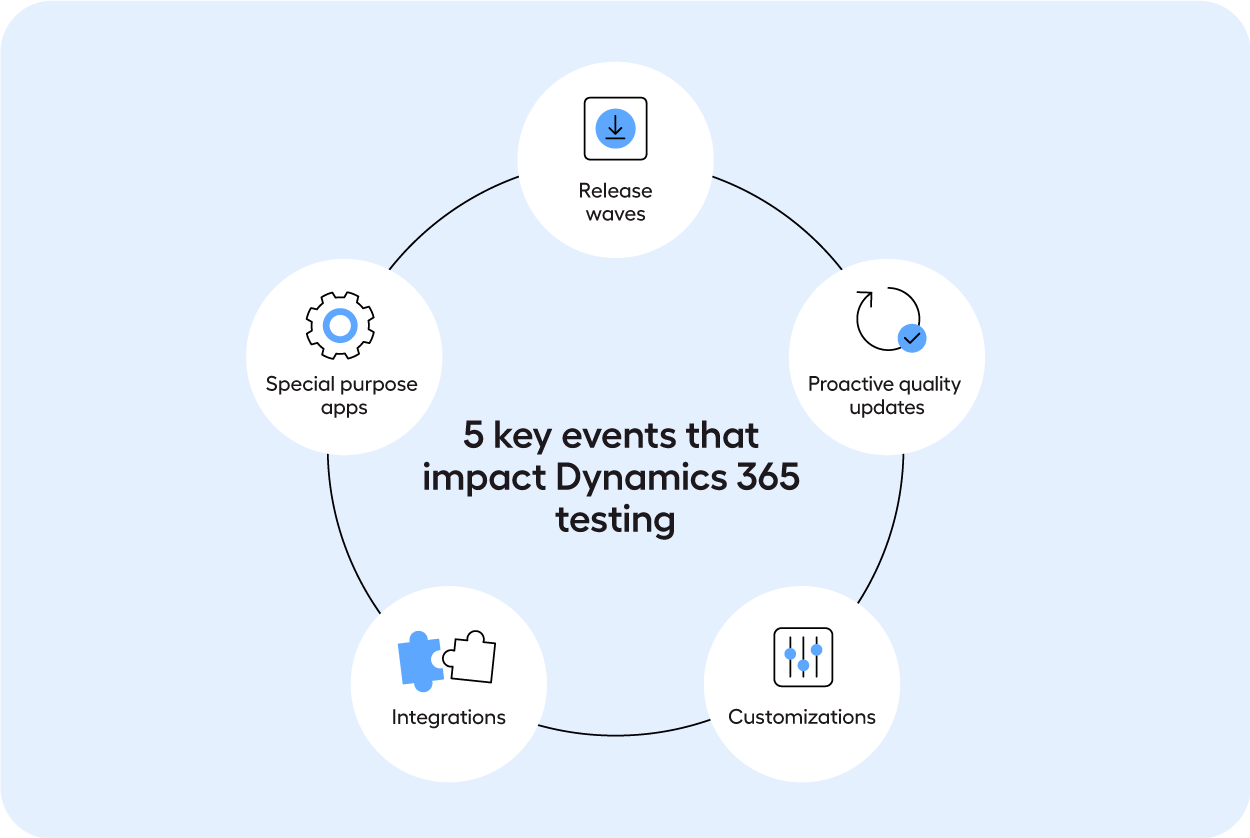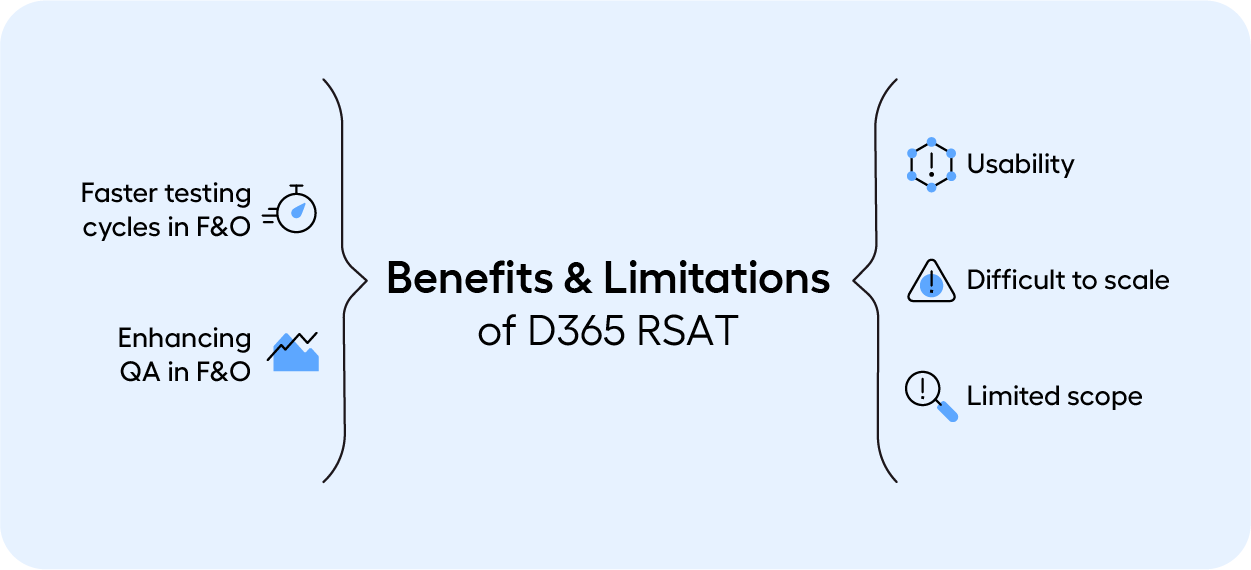What is Dynamics 365 RSAT?
Your customers and employees rely on the Microsoft solutions that make up your most critical business processes, which means they need to work. Ensuring the quality of these systems including Dynamics 365 Finance and Operations (F&O), is no easy feat. These are interconnected software ecosystems, where even the smallest defect can disrupt the flow of business and have severe, compounding consequences. This is where Dynamics 365 RSAT comes in.
In this article, we will explore what Dynamics 365 RSAT is and the benefits and limitations it brings in helping organizations maintain the quality of their D365 F&O application.
Skip to:
Why do you need to test Dynamics 365 F&O?
The challenges of testing Dynamics 365
What is RSAT and what are its capabilities?
What are the benefits and limitations of RSAT?
Using Leapwork to test Dynamics 365
Why do you need to test Dynamics 365 F&O?
Testing Dynamics 365 F&O is essential to ensure the quality and continuity of ERP (enterprise resource planning) and finance processes and capabilities, as well as preventing critical incidents that could negatively impact user experience.
To ensure this quality, testing should be done on several levels, spanning from functional validation of features within modules, to testing across integrations to validate processes across applications.
And it’s not only new functionality that needs to be tested, but also existing functionality when something new is introduced. This is what we know as regression testing in Dynamics.
Regression testing of key business processes is perhaps the most important aspect of securing quality, yet is often compromised because it requires significant investment in resources.
And, this has become especially pressing since Microsoft's One Version update process, which involves fewer but more impactful updates, meaning that businesses need to rethink and adjust their release and testing strategies to match.
Ensuring your business has the latest Microsoft innovations and critical security patches is vital for a successful application ecosystem as it provides users with more features, automation and AI capabilities. However, ensuring everything is running smoothly can be a resource-intensive task.
The challenges of testing Dynamics 365
Testing D365 F&O is a complex affair for a few reasons:
The application is nearly always highly customized and often integrated with other applications. In addition, D365 applications undergo frequent updates, including the aforementioned Microsoft One Version.

These factors impact the requirements for testing.
You need to allocate significant resources to planning, documenting, executing, maintaining, and reporting on testing activities. As a solution to this, automation can be introduced to reduce the Dynamics 365 manual testing effort and overall test cycle time.
What is RSAT and what are its capabilities?
The Regression Suite Automation Tool (RSAT) was introduced by Microsoft as a testing solution for its D365 F&O customers to assure the quality of processes that run within the application.
It was built to help organizations be in a ready state to accept new updates from Microsoft. This is a part of Microsoft's greater mission to help organizations streamline operations and enhance productivity within the Dynamics 365 F&O module.
It achieves this objective by enabling Microsoft F&O customers to orchestrate the validation of processes and report on these to give insight into their performance.
In other words, it checks that the processes running within F&O run as intended.
From a technical perspective, the way it works is that you create or automate your processes with F&O. This could, for example, be an order-to-cash or procure-to-pay process, and F&O saves that as a recording file. This recording file is then copied into RSAT where you can parameterize and orchestrate the execution to validate the recorded process.
It's important to note, however, that Microsoft suggests other solutions than RSAT for their customers looking to regression test across unique configurations and extensions.
What are the benefits and limitations of RSAT?
Using RSAT to test your regression cases comes with pros and cons.

The benefits of RSAT for D365 F&O include:
- Faster testing cycles: Through automation, manual testing efforts can be reduced. Dynamics regression testing can be very time-consuming and is a prime candidate for automation that can save QA teams valuable time. RSAT was built with this benefit in mind.
- Quality enhancements: By reducing manual testing and increasing automation, more testing can be covered. This will result in greater confidence in business processes. By minimizing repetitive manual regression testing, human error, which is inherent to manual testing, is reduced.
RSAT also has its limitations:
- Usability: RSAT can be a challenge to set up, configure, and maintain. It requires cross-functional technical expertise, in addition to knowing the ins and outs of the business requirements for D365 F&O, you also need to have a strong foundational knowledge of testing frameworks and code - a rare talent combination that’s hard to find.
- Difficult to scale: When changes to D365 occur, whether due to new releases or system updates, RSAT test cases need to be maintained. This means re-recording every single test that breaks. And because RSAT requires technical know-how, only a special subset of people will be able to do this. This creates bottlenecks in many QA teams and makes it difficult to reach the full potential of automation.
- Limited scope: RSAT works only with D365 F&O. It cannot be used with other applications in D365 or beyond. For businesses with processes spanning across multiple applications and technologies, this puts a cap on scalability and limits end-to-end testing.
From a business perspective, the negative impact of these limitations include high Total Cost of Ownership (TCO) and high Total Time to Market (TTM), and as a result, a reduced Return on Investment (ROI).
Read more: How to Reduce Dynamics 365 Quality Assurance Total Cost of Ownership
When you're evaluating the long-term costs and benefits as well as the financial viability of your investment, it is important to consider these metrics when you make the case for automation in your organization.
By approaching automation differently, through a composable, reusable, end-to-end test automation solution like Leapwork, you won’t experience the above limitations.
So what sets RSAT and Leapwork apart? Below, we will compare the capabilities so you can make an informed decision about your testing approach.
Related reading: Top 3 D365 RSAT Alternatives
Using Leapwork to test Dynamics 365
Leapwork is a strategic Microsoft partner, and the Leapwork Test Automation Platform is recommended for regression testing by Microsoft CTO of Dynamics 365, Mike Ehrenberg:
"Leapwork's no-code experience for test creation empowers a broader percentage of our customers to effectively implement automated testing. Enhancing the quality of their Microsoft Dynamics 365 service experience and lowering the total cost of ownership through Leapwork is a win-win opportunity."
Leapwork helps software testing teams to ensure quality across their Microsoft applications ensuring that customer experiences are great, operations are uninterrupted, and business continues to flow. This includes Dynamics 365.
The below Microsoft TechTalk digs into how users can regression test across Dynamics 365 applications with Leapwork, covering topics like its solution capabilities, DevOps integration, Order to Cash demo and more:
How is RSAT restricted in scope compared to Leapwork?
While RSAT offers basic testing capabilities for Dynamics 365, its functionality is limited when compared to a more comprehensive solution like Leapwork.
RSAT’s limitations become clear in several key areas:
- RSAT cannot support end-to-end testing
- The tool cannot support complex, data-driven testing scenarios
- RSAT is very technical, eliminating business users from using it
- The tool is difficult to maintain and scale
In contrast, Leapwork is purpose-built to simplify and automate regression testing for Dynamics 365, offering a more robust, scalable, and user-friendly approach.
Why is Leapwork ideal for Dynamics 365 regression testing?
1. Ease of use
Leapwork is a completely composable tool that allows users to build complex test flows visually without using code. This, of course, means that any user can work with testing, eliminating barriers to entry as no code is required to build or understand test automation. This doesn’t just make it easier and quicker to get up-and-running with automation from the most technical user to a general business user, it also means far less time is spent on maintenance.
2. Low maintenance
Maintenance is a burden that is easy to forget up front, but it shows its face as teams try to scale automation. What sets Leapwork apart from other solutions is how little maintenance it requires. You can run your entire regression suite automatically after every build, and can easily scale and maintain with reusable test flows.
This also means that tests won’t break with every One Version update due to pre-built intelligent adaptors designed to handle the complex and dynamic DOMs in D365 F&O.
Not only that, but on the rare occasion that something does break, it takes a fraction of the time to find the root cause and fix it. Through a hypervisual approach to debugging, Leapwork makes it simple to pinpoint the exact place a test broke.
3. Cross-technology capabilities
The biggest limitation of RSAT is that it is built only for Dynamics 365 F&O, and won’t allow you to test across other applications or technologies. Core business processes often involve multiple applications, and in order to test those processes, the tool must work cross-platform.
Leapwork can be used across all these applications allowing you to test end-to-end. This means that you can not only cover the entire Dynamics 365 application portfolio, but other Microsoft applications and everything from Salesforce and SAP to Mainframe and Citrix.
Companies can also test on any platform, web, desktop, mobile, mainframe, and APIs.
4. Test faster
Leapwork dramatically shortens the test execution cycle, allowing teams to go from days or hours of manual regression testing to minutes with automated, AI-powered test flows that are capable enough for the most complex data driven use cases.
This is especially valuable for large and complex implementations of Dynamics 365, where quick iterations are needed to keep pace with continuous updates and deployments.
5. Govern at scale
Enterprise-grade governance is built into Leapwork’s DNA. With full support for audit trails, change tracking, and video-based reporting, Leapwork ensures transparency across your test lifecycle. For organizations using D365 F&O in regulated industries, this is especially crucial to ensure compliance.
Role-based access controls and full Active Directory integration provide secure user management and ensure only the right people can make changes to automation assets. With built-in dashboards and reports, stakeholders gain visibility into testing status and coverage.
6. Seamlessly integrate
Leapwork fits naturally into existing development and release pipelines. With native integrations into Azure DevOps, including test plans and CI/CD pipelines, it enables teams to automate regression testing as part of their broader DevOps practices. The benefit is this removes silos and enables cross-functional teams to collaborate efficiently and maintain alignment across development, QA, and operations.
7. Validate AI
Business applications are increasingly including AI-driven components and Microsoft is no different with its Microsoft AI Copilot. Leapwork allows companies to extend regression testing to validate AI-generated suggestions and automated processes, verifying whether the AI behavior is consistent, accurate, and aligned with business goals. Testing the reliability of Copilot responses across scenarios is vital in ensuring AI-powered workflows deliver value without introducing risks.
Learn more about Dynamics 365 testing
If you want to learn more about how to automate Dynamics 365 testing and dramatically reduce the hours your organization spends on testing, you can:
➡️ Get our complete guide for testing Dynamics 365
➡️ Watch our webinar on how Ascensus unlocked a new mindset for Microsoft Dynamics test automation with Leapwork
➡️ Download our Dynamics 365 Solution Brief
